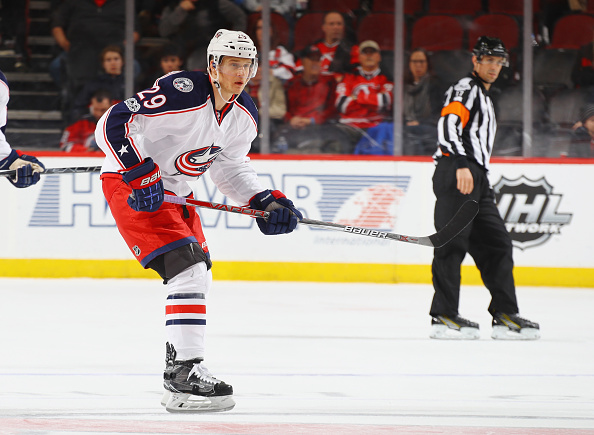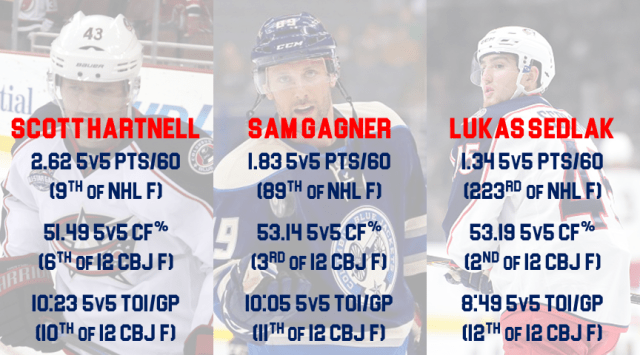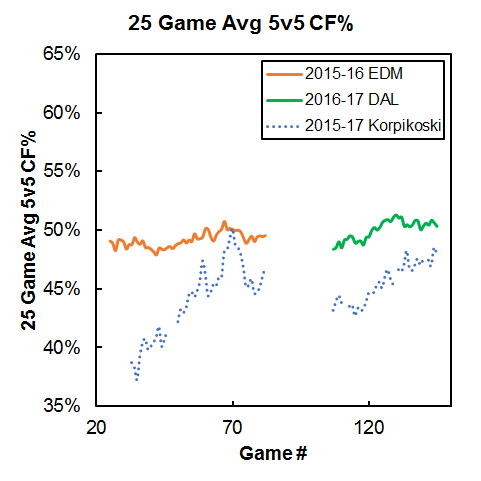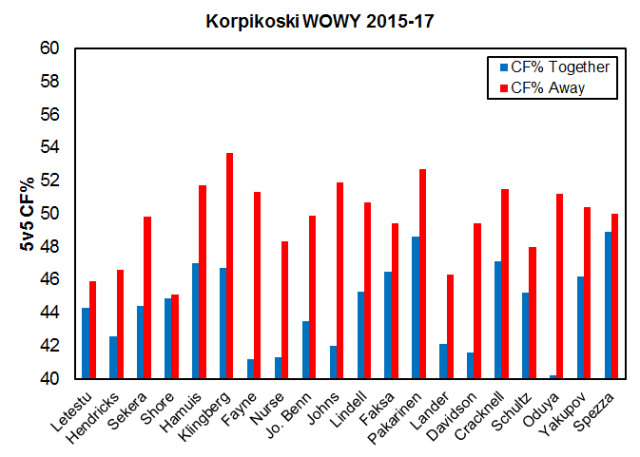It’s weird to be a Columbus fan and feel disappointed in a lack of action at the trade deadline. For too many years, the Blue Jackets have been a source of anxiety around March 1st, a team typically in the midst of another sell-off. This time around, the story was different. The Jackets were (and still are) comfortably in a playoff spot, suggesting a chance for an upgrade or a rental. Blame whatever you want (high prices, expansion draft uncertainty), the impact moves just didn’t happen for anybody (outside of Washington with Shattenkirk). Instead, Columbus made two minor moves to help bolster depth. The first: defenseman Kyle Quincey in return for Dalton Prout. Quincey is at worst a lateral move, and perhaps an upgrade over the penalty-prone Jersey-bound d-man. The other: a move for winger Lauri Korpikoski. It’s the forward move that could be a problem as the season ends.
Impressive Columbus Forward Depth
Throughout the 2016-17 season, Columbus has implicitly placed an emphasis on using skilled forwards across all four lines. The changes happened in the off-season, as the Jackets bought out Jared Boll and started the work toward termination of Gregory Campbell’s contract. In place of two liabilities in the shot department, the team structured 3rd and 4th line choices around viable hockey players.
Over the course of the season, the Blue Jackets have managed to “hide” players like Scott Hartnell, Sam Gagner, Lukas Sedlak, Matt Calvert, and Josh Anderson in 3rd or 4th line roles (at least by time on ice). The oldest traditional grind-line/energy-player descriptors don’t fit for many of these players, even if their style can tend toward the physical.
Scott Hartnell is secretly among the 10 most impactful even strength scorers in the NHL (minimum 400 minutes, via Hockey Analysis). Sam Gagner received attention for his powerplay contributions and then a lengthy goal drought (but thankfully that’s over). Behind the traditional counting stats, Gagner’s been part of an impressive shot differential effort that I’ve covered on this site. His impacts haven’t changed since that article was published a month ago. Lukas Sedlak has quietly built one of the best CF% on the team (sitting at a solid 53.19%, via Natural Stat Trick).
My three specific examples all rank fairly low on the Jackets in average 5v5 time on ice per game. Hartnell is 10th, Gagner 11th, Sedlak 12th among the 12 most frequent CBJ forwards, all three hovering around 10 minutes per game (via Natural Stat Trick). Here’s a handy graphic to consider for all three key depth players.
Data from Natural Stat Trick and Hockey Analysis, current prior to games on 3/9. Photos from Wikimedia Commons and Getty through The Sports Daily/Bloguin license.
The main takeaway: even in the low TOI situations, the Blue Jackets are built to win matchups, thus providing a depth advantage that’s hard to match.
Or, perhaps we should be talking in past tense. The Jackets were built that way throughout most of the season. Because the tables have shifted a bit in recent weeks.
The Injuries and a Shallow Forward Pool
Sedlak is out with an oblique strain (via Tom Reed, Columbus Dispatch). Matt Calvert is out with an oblique injury (shared by the CBJ). Josh Anderson is out with a lower body injury (via Aaron Portzline, Columbus Dispatch). Suddenly the roster must be shuffled around, and the depth advantage isn’t quite there anymore.
Call-ups have helped (Oliver Bjorkstrand is on a solid scoring run, TJ Tynan is on an emergency recall yo-yo back and forth from Cleveland), but the trade deadline helped to bring in a final (temporary) puzzle piece to help cover the sudden depth problems.
Unfortunately, Lauri Korpikoski has not been a good answer to the Columbus problems. The issue is not Korpikoski the person, but the player. Over the past two seasons, the results just haven’t been there for Korpikoski, either from a scoring perspective or a shot differential context.
For the former: consider that Korpikoski is 285th among all forwards over the last two years in points per 60 minutes at 5v5, with 1.02 pts/60 (minimum 500 minutes, via Hockey Analysis). NHL lineups, on average, have access to 9-10 forwards scoring at his rate per team. In that sense, it’s a reasonable depth pickup, but a noted downgrade from the scoring impact of Anderson or Sedlak (1.89 pts/60 and 1.34 pts/60, via Hockey Analysis). In addition, Korpikoski is already 30, already on the wrong side of the scoring rate age curve.
The real downgrade comes in the form of shot differential. Using data from Corsica, we can consider Korpikoski’s performance over each of the last two seasons as compared to the average performance of his teams (Edmonton in 2015-16, Dallas in 2016-17). We’ll look at the 25-game average of 5v5 Corsi For percentage for the 2015-16 Edmonton Oilers (shown in orange), the 2016-17 Dallas Stars (shown in green), and Korpikoski (the dashed blue line). The picture isn’t so pretty.
Data from Corsica’s Skater and Team Stats
The conclusion: Lauri Korpikoski has regularly been below team average in shot differential. This means that, relative to team, the winger is part of surrendering more shots against, and thus not helping to make obvious positive impacts.
The story only becomes more concerning when considering how players in Edmonton and Dallas fared away from Korpikoski. Using data from Hockey Analysis, we can construct a bar chart of the 20 most common teammates with Korpikoski by time on ice. The blue lines are CF% with Korpikoski, and the red are the CF% of that same player when apart from the winger.
Data from Hockey Analysis
Every single player gets a boost when apart from Korpikoski. It’s not an encouraging picture, but perhaps points to the endgame for the Jackets: wait for a return to full health.
Hockey Philosophy: Avoiding the Cuts
Losing a few shifts every so often in the course of a hockey game is unavoidable. So many factors enter any given stretch of play, that we shouldn’t be discouraged to see a player like Brandon Saad stuck in the defensive zone a few times a game. On average, we know Saad’s pushing play the right way, that he’s a massive positive influence on the team.
The issue comes in consistently losing a battle. Unfortunately for Columbus, Lauri Korpikoski’s impact was largely negative in each of the past two years, and hasn’t amounted to much since his move to Columbus. Three of his first four games resulted in sub-35% CF% performances (via Natural Stat Trick).
The silver lining here, is that Korpikoski has averaged around 9 minutes per game since joining the Jackets (via Hockey-Reference). However, it’s a complicated silver lining, as the team successes early in the season came (in part) thanks to overall forward depth that helped avoid significant missteps.
The circular issue here: Korpikoski isn’t eating big minutes, so he’s not making giant impacts on the team. At the same time, the team is losing the overall puck battle during his minutes, and thus shrinking the margin for error for other players who must be that much better to overcome a newly formed depth disadvantage.
A philosophy that translates well to hockey: teams must be careful to avoid death by a thousand cuts. No team will make perfect decisions 100% of the time. Even the most successful franchises have weird contracts or anchor players in their lineup (see: the Toews deal in Chicago, Tom Sestito in Pittsburgh, the Quick contract in Los Angeles). The goal, however, is to avoid as many cuts as possible. Because while any one error may only sting in isolation, many small problems can add up and severely impact an NHL team.
The hope for Columbus in the 2016-17 season is that team health returns in time for the playoffs, and that smart roster choices can return. At this point, it’s nearly impossible for the Jackets to drop from playoff contention. While the end of the regular season will help determine seeding, the true goal is already within grasp. If Sedlak, Calvert, and Anderson can return to health and displace Korpikoski, the road to Stanley Cup Playoff success will become that much easier.
Add The Sports Daily to your Google News Feed!



